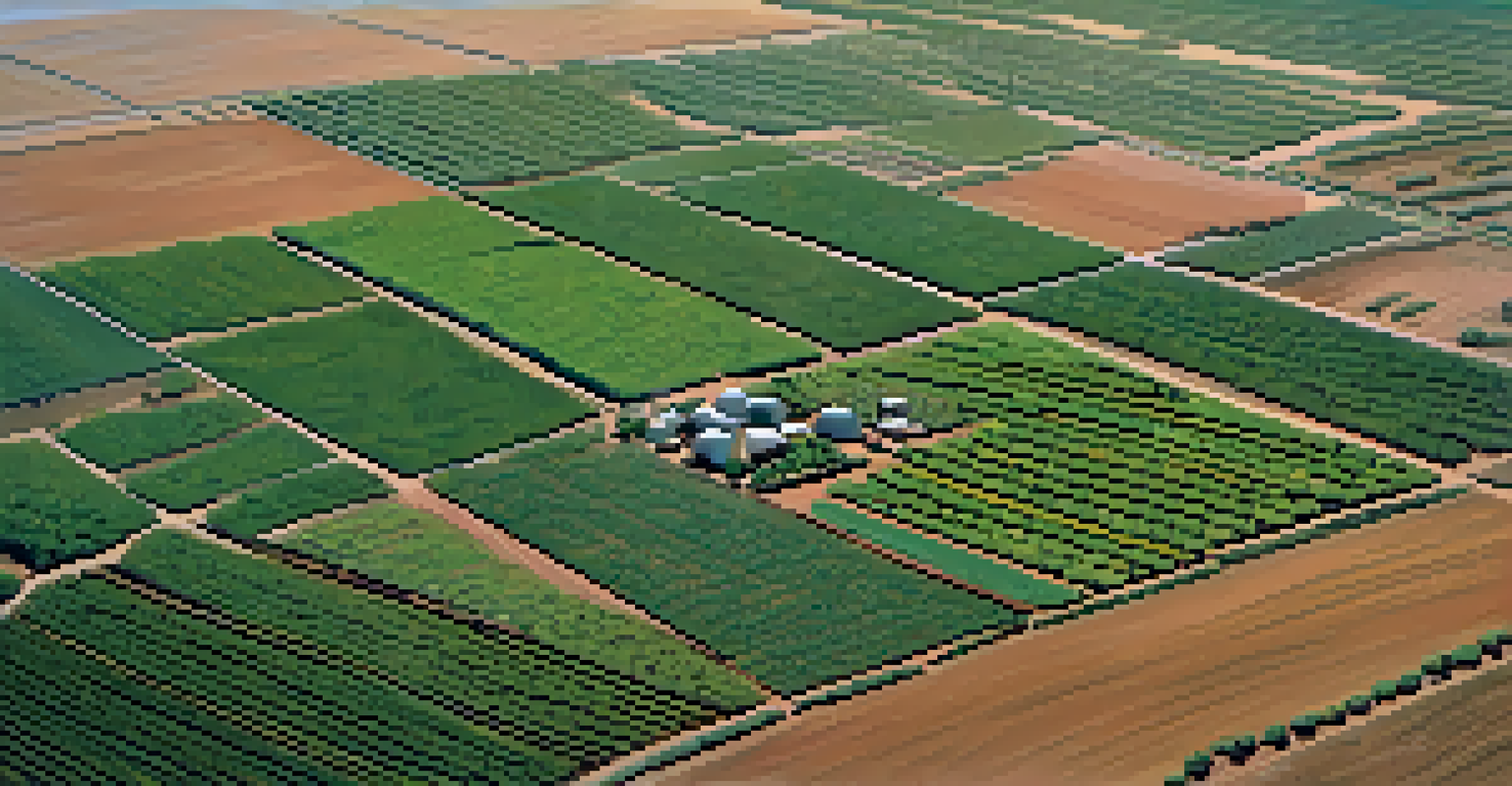The Impact of Climate on Arizona's Agricultural Products

Understanding Arizona's Unique Climate Conditions
Arizona is known for its diverse climate, ranging from arid deserts to temperate highlands. This variety affects agricultural practices significantly. The state experiences high temperatures and low rainfall, which are critical factors for farming decisions.
In the face of climate change, the agricultural sector must adapt or face the consequences.
Farmers must adapt to these conditions by selecting drought-resistant crops and implementing water-saving technologies. For instance, the use of drip irrigation has become common, allowing for precise watering that conserves resources. This method not only supports crop growth but also maximizes yield in challenging environments.
Moreover, the distinct climate zones in Arizona create opportunities for different types of agriculture. From citrus orchards in the southern regions to the hearty crops in the northern highlands, understanding these local climates is essential for successful farming.
The Role of Temperature in Crop Selection
Temperature plays a pivotal role in determining which crops thrive in Arizona. Given the state's hot summers, farmers often opt for heat-tolerant varieties. Crops like cotton and certain types of melons flourish under these conditions, providing vital economic benefits.

However, the rising temperatures due to climate change pose new challenges. Some traditional crops may struggle to adapt, leading farmers to explore alternative options. This shift not only impacts local economies but also the types of produce available in markets.
Climate Shapes Arizona Agriculture
Arizona's diverse climate significantly impacts farming practices, requiring farmers to adapt to varying temperature and water availability.
Additionally, the timing of planting and harvesting is closely linked to temperature patterns. Understanding seasonal temperature fluctuations helps farmers optimize their schedules, ensuring they maximize productivity throughout the growing season.
Water Availability and Its Impact on Agriculture
Water scarcity is a significant concern for Arizona agriculture, primarily due to its dry climate. Farmers rely heavily on irrigation systems, primarily drawing from the Colorado River and underground aquifers. The limited water supply necessitates careful management and innovative farming practices.
Sustainable agriculture is a way of life that respects the earth and its resources.
In response to these challenges, many farmers are investing in sustainable practices, such as rainwater harvesting and soil moisture monitoring. These methods not only help conserve water but also improve crop resilience. For example, using cover crops can enhance soil health and reduce evaporation.
The ongoing debate over water rights and allocation further complicates the agricultural landscape. As competition for water resources increases, farmers must navigate these issues to sustain their livelihoods and maintain productive farms.
The Influence of Seasonal Changes on Crop Production
Seasonal changes in Arizona can significantly affect crop production. The state experiences distinct seasons, each with its own temperature and precipitation patterns that influence growth cycles. Understanding these seasonal shifts helps farmers plan effectively.
For example, the mild winters allow for extended growing seasons, enabling farmers to cultivate a variety of crops year-round. This is particularly advantageous for fruits and vegetables, which thrive in cooler temperatures before the summer heat sets in.
Water Scarcity Drives Innovation
With limited water resources, Arizona farmers are increasingly adopting sustainable practices like rainwater harvesting and soil moisture monitoring.
However, unexpected weather events, such as late frosts or early heatwaves, can disrupt these plans. Farmers must stay vigilant and adaptable, often relying on weather forecasts and historical data to mitigate risks and protect their harvests.
Pest and Disease Management in a Changing Climate
Climate change also affects pest and disease dynamics in Arizona agriculture. Warmer temperatures can lead to prolonged pest seasons and the emergence of new species. Farmers need to be proactive in managing these threats to protect their crops.
Integrated Pest Management (IPM) strategies are becoming increasingly essential. By combining biological controls with chemical methods, farmers can effectively minimize pest damage while reducing environmental impact. For instance, introducing beneficial insects can help keep harmful pests at bay.
Moreover, staying informed about pest populations and disease outbreaks is crucial. Farmers often collaborate with agricultural extension services to receive the latest information and support for managing these challenges efficiently.
The Economic Implications of Climate on Farming
The impact of climate on agriculture extends beyond the fields; it has significant economic implications as well. Fluctuations in crop yields directly influence market prices, which can create uncertainty for farmers. For instance, a drought year can drastically reduce yields, leading to higher prices for consumers.
Additionally, the cost of implementing climate-resilient practices can be a barrier for some farmers. While investing in technology and sustainable practices is essential for long-term viability, the initial costs can be daunting. Government programs and grants may help offset these expenses, providing crucial support.
Economic Effects of Climate Change
Fluctuations in climate directly affect crop yields and market prices, compelling farmers to innovate and seek support for sustainable practices.
Ultimately, the interconnectedness of climate and economics underscores the need for adaptive strategies. Farmers who embrace innovation and sustainability are better positioned to thrive in an evolving agricultural landscape.
Future Outlook: Adapting Agriculture to Climate Change
Looking ahead, Arizona's agricultural sector faces both challenges and opportunities in the face of climate change. As temperatures rise and weather patterns shift, farmers must continue to adapt their practices. This may involve exploring new crop varieties, improved irrigation methods, or even altering planting schedules.
Collaboration among farmers, researchers, and policymakers will be essential for developing effective strategies. By sharing knowledge and resources, the agricultural community can work together to build resilience against climate impacts. For example, pilot projects showcasing successful adaptation practices can serve as models for wider implementation.

Ultimately, the future of Arizona agriculture depends on a proactive approach to climate adaptation. By embracing change and investing in sustainable practices, farmers can not only ensure their survival but also contribute to a more resilient agricultural system.